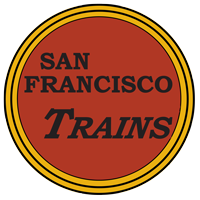The Bayshore Cutoff
The San Francisco & San Jose Railroad was completed in January 1864, but the route into the City from San Bruno was not the one Caltrain takes today. Trains instead climbed up into the Merced Valley through Colma and Daly City, roughly where BART travels today, then snaked downhill across the Mission District and onto Harrison Street. The stiff 2% ruling grade of the original route often required “helper engines” on trains over the summit. It was common at that time to see as many as three engines at the head of the train.
The notion of a “water level” railroad route along the east flank of San Bruno Mountain was not a new one (in fact, the earliest known proposal for a railroad on the Peninsula featured this routing!), but the capital costs would have been utterly ruinous for an upstart venture like the SF&SJ. The route taken was quickly recognized as an operational headache, with the transcontinental Southern Pacific Railroad (having entered a purchasing agreement with the SF&SJ in 1868) arguing that it could not haul freight profitably over the current line and getting the legislature to grant a right-of-way along the yet-to-be-filled-in southeastern waterfront of San Francisco.
It would take a long time for the southern waterfront to be filled in, however, and the railroad wasn’t particularly interested in expediting the process. Behind the scenes, Collis P. Huntington of Central Pacific fame obtained control of SP in short order, and massive capital expenditures on the line up the Peninsula weren’t an especially high priority in the context of his combined Central Pacific – Southern Pacific system. Huntington’s SP repeatedly entertained the idea throughout the 19th century, but time and time again it took a back seat to other railroad projects. Eventually, SP became sick of waiting – the section of the original right-of-way south of the City proper was not going to get filled in any time soon, and by 1892, the railroad realized it would need to survey a more practical route almost from scratch.
By the late 1890s, the “Bay Shore Railway” was finally gaining momentum. San Francisco had grown into a vibrant center of industrial production and shipping, and the original routing had become intolerable both to the railroad and the residents of the Mission District. The imminent completion of the Coast Route to Los Angeles provided even further impetus for expediting the project… but Huntington ultimately would not live to see a single shovel turned, dying suddenly in late 1900 while surveying work and land negotiations were still underway. Enter railroad financier Edward H. Harriman, who acquired control of Southern Pacific in 1901 and initiated many improvements. It would be under his control that the Bayshore Cutoff would finally be built, but it would require five tunnels, miles of trestlework, gargantuan cuts and fills, and would ultimately cost a million dollars a mile.

Construction on the ambitious reroute began in 1904. From San Bruno the new line was laid northeast to a tunnel at Sierra Point. Then, it skirted along the shoreline to Visitacion Point, where an enormous cut was made into the hillside. Instead of contorting to hug the shoreline from here (which was just to the east of Bayshore Boulevard), a two-mile-long double-tracked trestle (where the Caltrain tracks are now) shot across Visitacion Bay. Four more tunnels along with additional fills and trestles brought the tracks north through Bayview, across the Islais Creek Basin, and under Potrero Hill to the Southern Pacific’s 3rd & Townsend terminal in Mission Bay.
The Great Earthquake of 1906 had a hand in prolonging the task. The still-unstable causeways that had been constructed around Visitacion Bay slumped into the water and track slid off with it. Once that was fixed, a shortage of rails and yet more damage to the causeways (this time from heavy rain storms) pushed the completion date back even further. Finally, after 3 long years of construction, the Bayshore Cutoff opened for service on December 8, 1907.
With the Cutoff itself up and running, Harriman’s Southern Pacific turned its attention to filling in Visitacion Bay, where a massive new sorting yard was in the works to handle the burgeoning freight traffic going into and out of the City…
